Analysis of Nestle's Business Environment and Organizational Functions
VerifiedAdded on 2020/06/06
|11
|3523
|196
Report
AI Summary
This report presents a comprehensive analysis of Nestle's business environment, focusing on its internal and external factors. It examines the interrelationship between various organizational functions, such as finance, HR, production, and marketing, and their link to the company's structure and objectives. The report delves into the positive and negative impacts of the macro environment, including political, legal, technological, economic, environmental, and social factors, on Nestle's operations. Furthermore, it conducts a SWOT analysis to identify the company's strengths, weaknesses, opportunities, and threats. The analysis highlights Nestle's research and development capabilities and geographic presence as strengths, while also acknowledging weaknesses such as criticism and product quality issues. Opportunities like clear product labeling and ready-to-drink product development are explored, along with threats such as competition and high coffee bean prices. The report concludes by emphasizing the importance of understanding and adapting to the business environment for strategic decision-making and achieving competitive advantages.
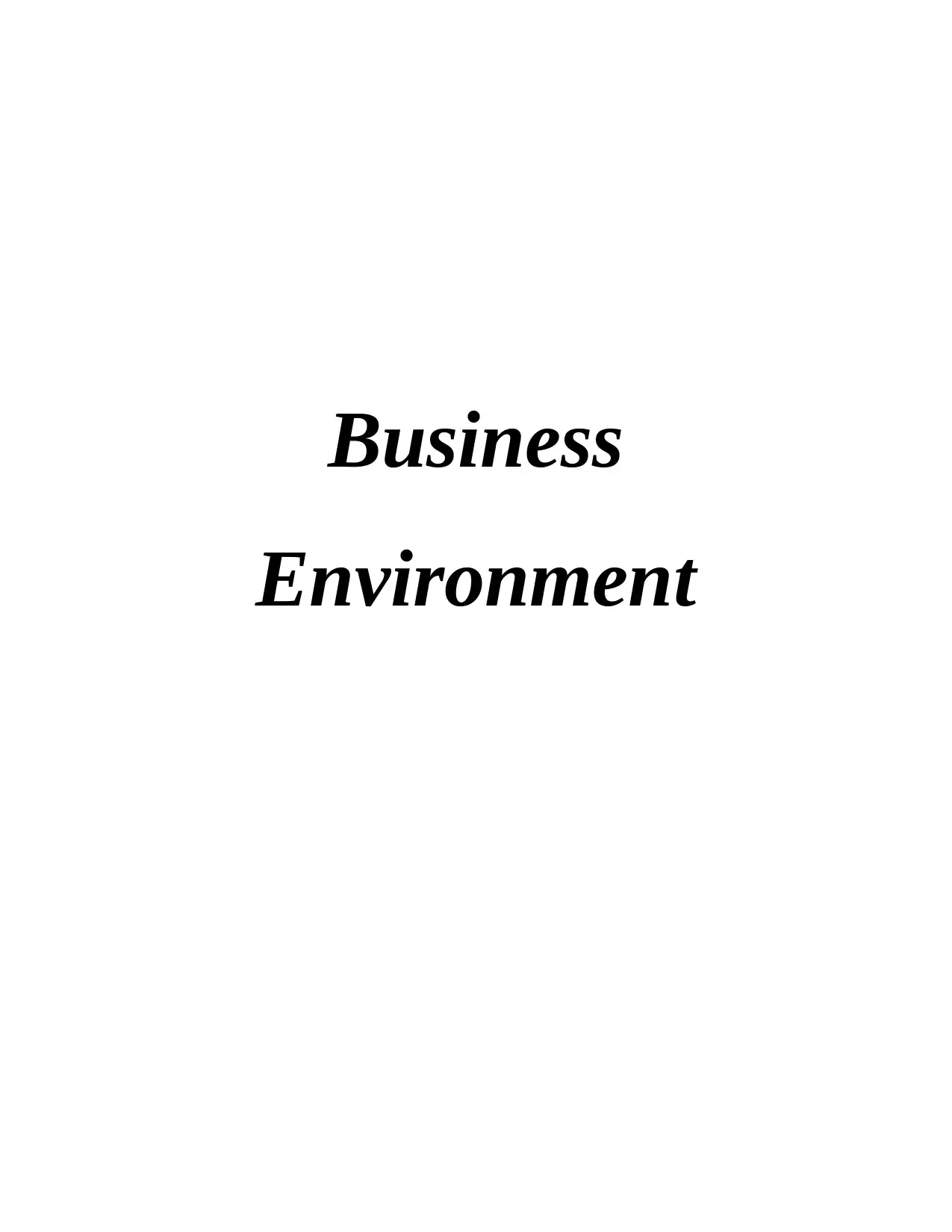
Business
Environment
Environment
Paraphrase This Document
Need a fresh take? Get an instant paraphrase of this document with our AI Paraphraser
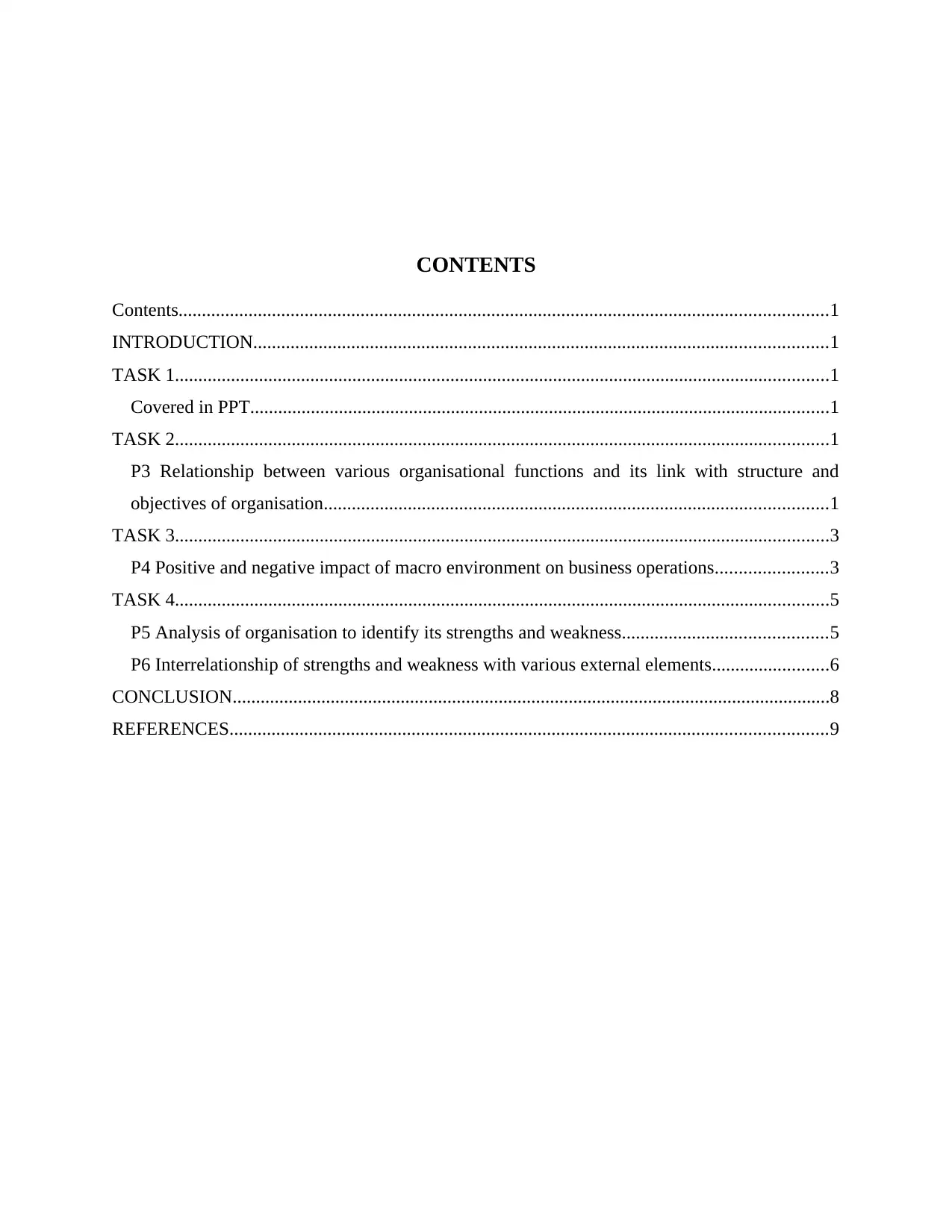
CONTENTS
Contents...........................................................................................................................................1
INTRODUCTION...........................................................................................................................1
TASK 1............................................................................................................................................1
Covered in PPT............................................................................................................................1
TASK 2............................................................................................................................................1
P3 Relationship between various organisational functions and its link with structure and
objectives of organisation............................................................................................................1
TASK 3............................................................................................................................................3
P4 Positive and negative impact of macro environment on business operations........................3
TASK 4............................................................................................................................................5
P5 Analysis of organisation to identify its strengths and weakness............................................5
P6 Interrelationship of strengths and weakness with various external elements.........................6
CONCLUSION................................................................................................................................8
REFERENCES................................................................................................................................9
Contents...........................................................................................................................................1
INTRODUCTION...........................................................................................................................1
TASK 1............................................................................................................................................1
Covered in PPT............................................................................................................................1
TASK 2............................................................................................................................................1
P3 Relationship between various organisational functions and its link with structure and
objectives of organisation............................................................................................................1
TASK 3............................................................................................................................................3
P4 Positive and negative impact of macro environment on business operations........................3
TASK 4............................................................................................................................................5
P5 Analysis of organisation to identify its strengths and weakness............................................5
P6 Interrelationship of strengths and weakness with various external elements.........................6
CONCLUSION................................................................................................................................8
REFERENCES................................................................................................................................9
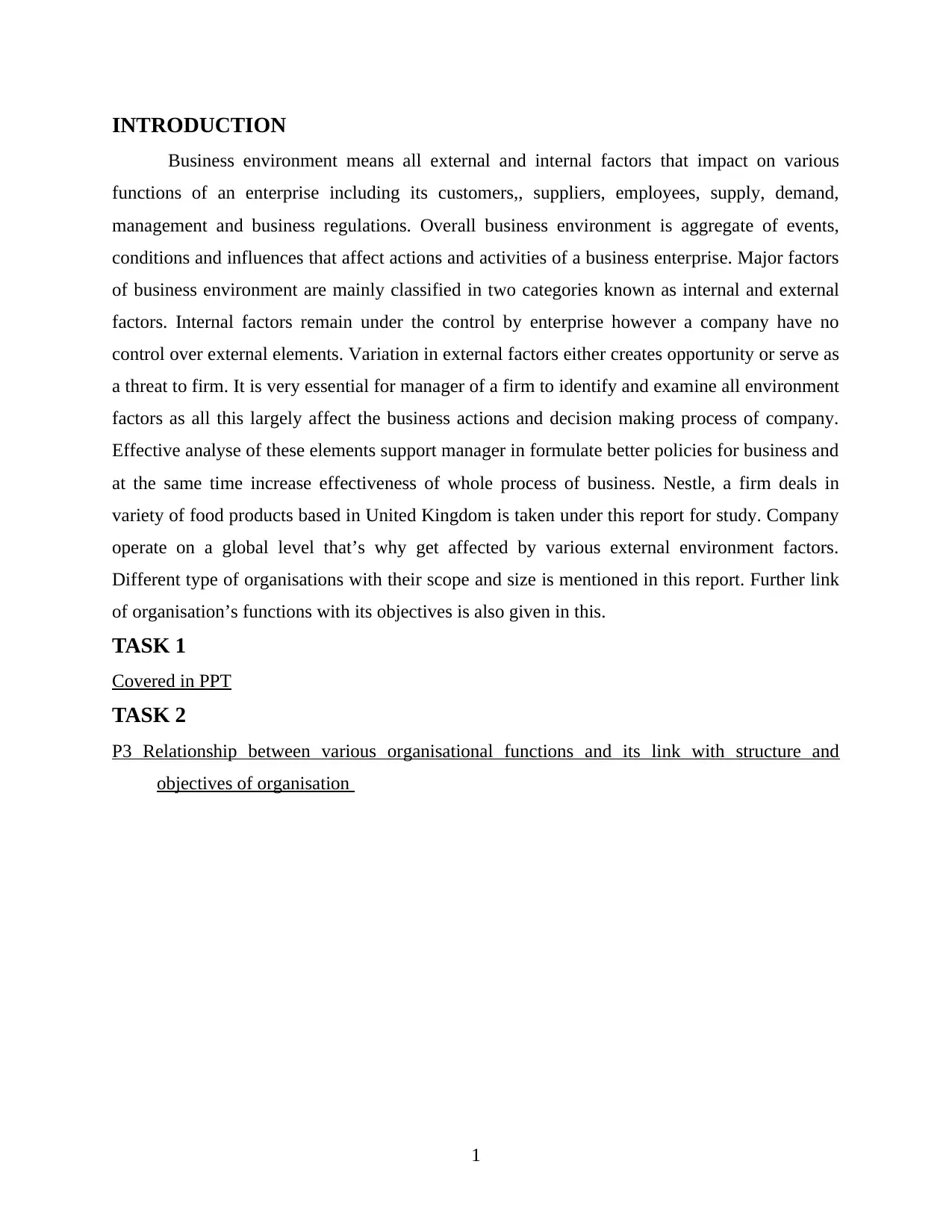
INTRODUCTION
Business environment means all external and internal factors that impact on various
functions of an enterprise including its customers,, suppliers, employees, supply, demand,
management and business regulations. Overall business environment is aggregate of events,
conditions and influences that affect actions and activities of a business enterprise. Major factors
of business environment are mainly classified in two categories known as internal and external
factors. Internal factors remain under the control by enterprise however a company have no
control over external elements. Variation in external factors either creates opportunity or serve as
a threat to firm. It is very essential for manager of a firm to identify and examine all environment
factors as all this largely affect the business actions and decision making process of company.
Effective analyse of these elements support manager in formulate better policies for business and
at the same time increase effectiveness of whole process of business. Nestle, a firm deals in
variety of food products based in United Kingdom is taken under this report for study. Company
operate on a global level that’s why get affected by various external environment factors.
Different type of organisations with their scope and size is mentioned in this report. Further link
of organisation’s functions with its objectives is also given in this.
TASK 1
Covered in PPT
TASK 2
P3 Relationship between various organisational functions and its link with structure and
objectives of organisation
1
Business environment means all external and internal factors that impact on various
functions of an enterprise including its customers,, suppliers, employees, supply, demand,
management and business regulations. Overall business environment is aggregate of events,
conditions and influences that affect actions and activities of a business enterprise. Major factors
of business environment are mainly classified in two categories known as internal and external
factors. Internal factors remain under the control by enterprise however a company have no
control over external elements. Variation in external factors either creates opportunity or serve as
a threat to firm. It is very essential for manager of a firm to identify and examine all environment
factors as all this largely affect the business actions and decision making process of company.
Effective analyse of these elements support manager in formulate better policies for business and
at the same time increase effectiveness of whole process of business. Nestle, a firm deals in
variety of food products based in United Kingdom is taken under this report for study. Company
operate on a global level that’s why get affected by various external environment factors.
Different type of organisations with their scope and size is mentioned in this report. Further link
of organisation’s functions with its objectives is also given in this.
TASK 1
Covered in PPT
TASK 2
P3 Relationship between various organisational functions and its link with structure and
objectives of organisation
1
⊘ This is a preview!⊘
Do you want full access?
Subscribe today to unlock all pages.

Trusted by 1+ million students worldwide
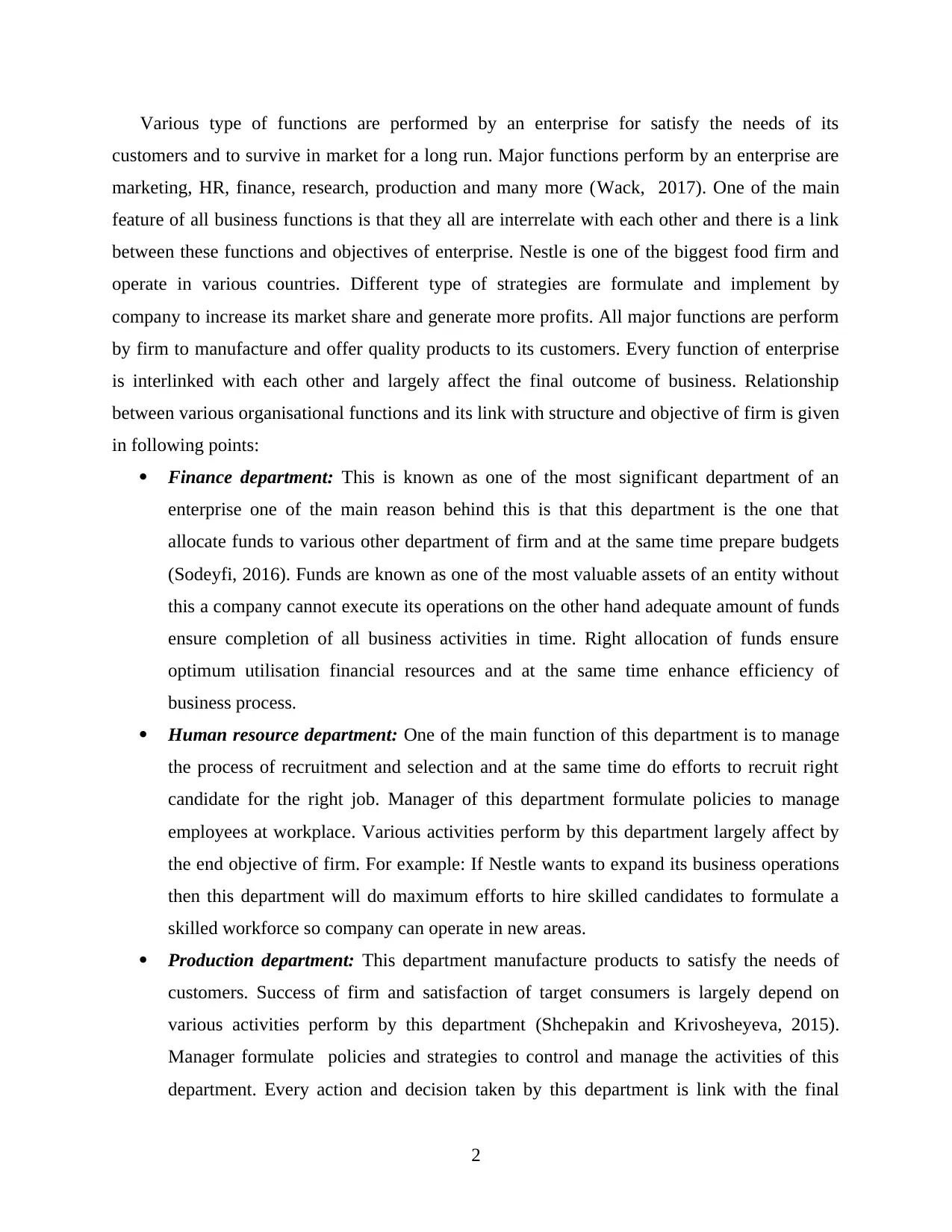
Various type of functions are performed by an enterprise for satisfy the needs of its
customers and to survive in market for a long run. Major functions perform by an enterprise are
marketing, HR, finance, research, production and many more (Wack, 2017). One of the main
feature of all business functions is that they all are interrelate with each other and there is a link
between these functions and objectives of enterprise. Nestle is one of the biggest food firm and
operate in various countries. Different type of strategies are formulate and implement by
company to increase its market share and generate more profits. All major functions are perform
by firm to manufacture and offer quality products to its customers. Every function of enterprise
is interlinked with each other and largely affect the final outcome of business. Relationship
between various organisational functions and its link with structure and objective of firm is given
in following points:
Finance department: This is known as one of the most significant department of an
enterprise one of the main reason behind this is that this department is the one that
allocate funds to various other department of firm and at the same time prepare budgets
(Sodeyfi, 2016). Funds are known as one of the most valuable assets of an entity without
this a company cannot execute its operations on the other hand adequate amount of funds
ensure completion of all business activities in time. Right allocation of funds ensure
optimum utilisation financial resources and at the same time enhance efficiency of
business process.
Human resource department: One of the main function of this department is to manage
the process of recruitment and selection and at the same time do efforts to recruit right
candidate for the right job. Manager of this department formulate policies to manage
employees at workplace. Various activities perform by this department largely affect by
the end objective of firm. For example: If Nestle wants to expand its business operations
then this department will do maximum efforts to hire skilled candidates to formulate a
skilled workforce so company can operate in new areas.
Production department: This department manufacture products to satisfy the needs of
customers. Success of firm and satisfaction of target consumers is largely depend on
various activities perform by this department (Shchepakin and Krivosheyeva, 2015).
Manager formulate policies and strategies to control and manage the activities of this
department. Every action and decision taken by this department is link with the final
2
customers and to survive in market for a long run. Major functions perform by an enterprise are
marketing, HR, finance, research, production and many more (Wack, 2017). One of the main
feature of all business functions is that they all are interrelate with each other and there is a link
between these functions and objectives of enterprise. Nestle is one of the biggest food firm and
operate in various countries. Different type of strategies are formulate and implement by
company to increase its market share and generate more profits. All major functions are perform
by firm to manufacture and offer quality products to its customers. Every function of enterprise
is interlinked with each other and largely affect the final outcome of business. Relationship
between various organisational functions and its link with structure and objective of firm is given
in following points:
Finance department: This is known as one of the most significant department of an
enterprise one of the main reason behind this is that this department is the one that
allocate funds to various other department of firm and at the same time prepare budgets
(Sodeyfi, 2016). Funds are known as one of the most valuable assets of an entity without
this a company cannot execute its operations on the other hand adequate amount of funds
ensure completion of all business activities in time. Right allocation of funds ensure
optimum utilisation financial resources and at the same time enhance efficiency of
business process.
Human resource department: One of the main function of this department is to manage
the process of recruitment and selection and at the same time do efforts to recruit right
candidate for the right job. Manager of this department formulate policies to manage
employees at workplace. Various activities perform by this department largely affect by
the end objective of firm. For example: If Nestle wants to expand its business operations
then this department will do maximum efforts to hire skilled candidates to formulate a
skilled workforce so company can operate in new areas.
Production department: This department manufacture products to satisfy the needs of
customers. Success of firm and satisfaction of target consumers is largely depend on
various activities perform by this department (Shchepakin and Krivosheyeva, 2015).
Manager formulate policies and strategies to control and manage the activities of this
department. Every action and decision taken by this department is link with the final
2
Paraphrase This Document
Need a fresh take? Get an instant paraphrase of this document with our AI Paraphraser
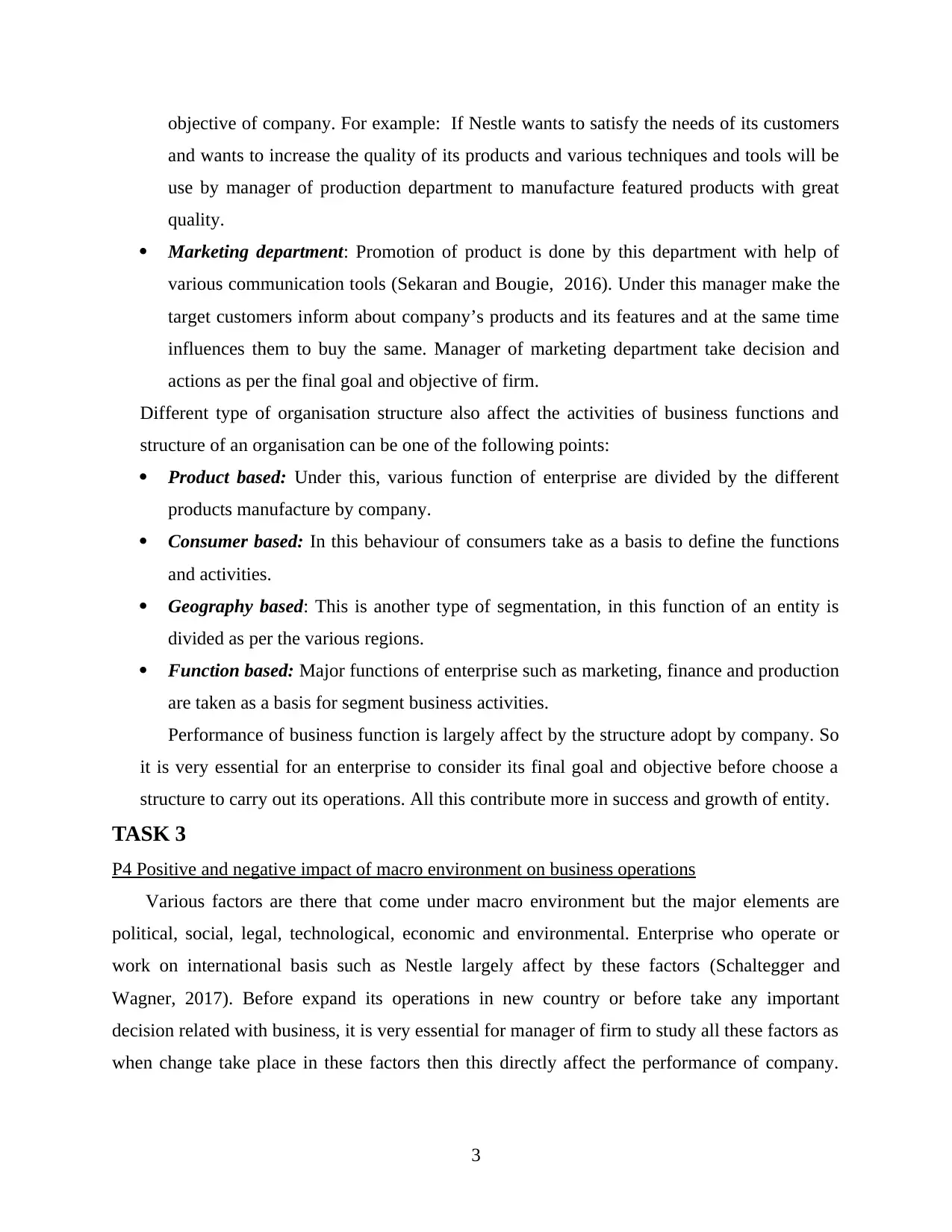
objective of company. For example: If Nestle wants to satisfy the needs of its customers
and wants to increase the quality of its products and various techniques and tools will be
use by manager of production department to manufacture featured products with great
quality.
Marketing department: Promotion of product is done by this department with help of
various communication tools (Sekaran and Bougie, 2016). Under this manager make the
target customers inform about company’s products and its features and at the same time
influences them to buy the same. Manager of marketing department take decision and
actions as per the final goal and objective of firm.
Different type of organisation structure also affect the activities of business functions and
structure of an organisation can be one of the following points:
Product based: Under this, various function of enterprise are divided by the different
products manufacture by company.
Consumer based: In this behaviour of consumers take as a basis to define the functions
and activities.
Geography based: This is another type of segmentation, in this function of an entity is
divided as per the various regions.
Function based: Major functions of enterprise such as marketing, finance and production
are taken as a basis for segment business activities.
Performance of business function is largely affect by the structure adopt by company. So
it is very essential for an enterprise to consider its final goal and objective before choose a
structure to carry out its operations. All this contribute more in success and growth of entity.
TASK 3
P4 Positive and negative impact of macro environment on business operations
Various factors are there that come under macro environment but the major elements are
political, social, legal, technological, economic and environmental. Enterprise who operate or
work on international basis such as Nestle largely affect by these factors (Schaltegger and
Wagner, 2017). Before expand its operations in new country or before take any important
decision related with business, it is very essential for manager of firm to study all these factors as
when change take place in these factors then this directly affect the performance of company.
3
and wants to increase the quality of its products and various techniques and tools will be
use by manager of production department to manufacture featured products with great
quality.
Marketing department: Promotion of product is done by this department with help of
various communication tools (Sekaran and Bougie, 2016). Under this manager make the
target customers inform about company’s products and its features and at the same time
influences them to buy the same. Manager of marketing department take decision and
actions as per the final goal and objective of firm.
Different type of organisation structure also affect the activities of business functions and
structure of an organisation can be one of the following points:
Product based: Under this, various function of enterprise are divided by the different
products manufacture by company.
Consumer based: In this behaviour of consumers take as a basis to define the functions
and activities.
Geography based: This is another type of segmentation, in this function of an entity is
divided as per the various regions.
Function based: Major functions of enterprise such as marketing, finance and production
are taken as a basis for segment business activities.
Performance of business function is largely affect by the structure adopt by company. So
it is very essential for an enterprise to consider its final goal and objective before choose a
structure to carry out its operations. All this contribute more in success and growth of entity.
TASK 3
P4 Positive and negative impact of macro environment on business operations
Various factors are there that come under macro environment but the major elements are
political, social, legal, technological, economic and environmental. Enterprise who operate or
work on international basis such as Nestle largely affect by these factors (Schaltegger and
Wagner, 2017). Before expand its operations in new country or before take any important
decision related with business, it is very essential for manager of firm to study all these factors as
when change take place in these factors then this directly affect the performance of company.
3
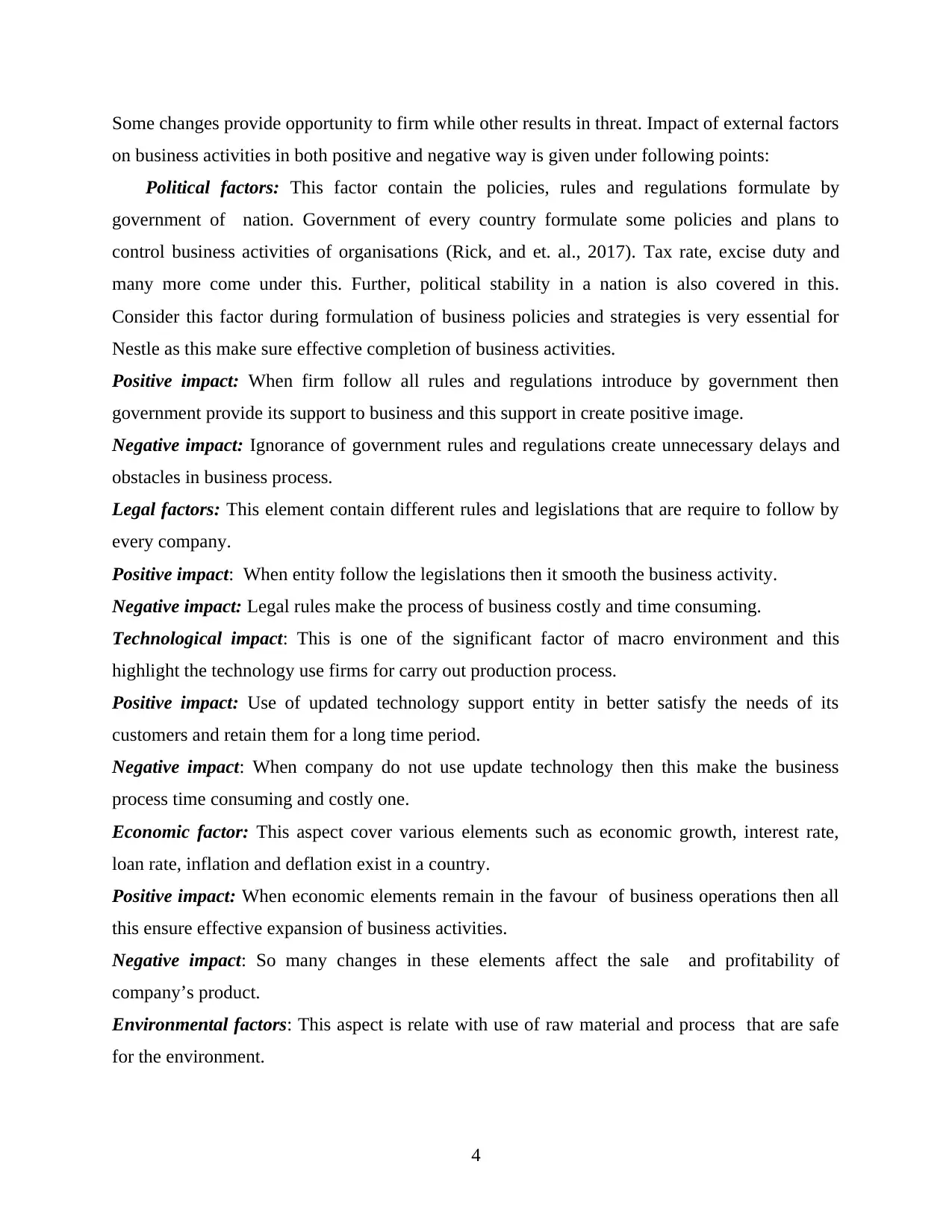
Some changes provide opportunity to firm while other results in threat. Impact of external factors
on business activities in both positive and negative way is given under following points:
Political factors: This factor contain the policies, rules and regulations formulate by
government of nation. Government of every country formulate some policies and plans to
control business activities of organisations (Rick, and et. al., 2017). Tax rate, excise duty and
many more come under this. Further, political stability in a nation is also covered in this.
Consider this factor during formulation of business policies and strategies is very essential for
Nestle as this make sure effective completion of business activities.
Positive impact: When firm follow all rules and regulations introduce by government then
government provide its support to business and this support in create positive image.
Negative impact: Ignorance of government rules and regulations create unnecessary delays and
obstacles in business process.
Legal factors: This element contain different rules and legislations that are require to follow by
every company.
Positive impact: When entity follow the legislations then it smooth the business activity.
Negative impact: Legal rules make the process of business costly and time consuming.
Technological impact: This is one of the significant factor of macro environment and this
highlight the technology use firms for carry out production process.
Positive impact: Use of updated technology support entity in better satisfy the needs of its
customers and retain them for a long time period.
Negative impact: When company do not use update technology then this make the business
process time consuming and costly one.
Economic factor: This aspect cover various elements such as economic growth, interest rate,
loan rate, inflation and deflation exist in a country.
Positive impact: When economic elements remain in the favour of business operations then all
this ensure effective expansion of business activities.
Negative impact: So many changes in these elements affect the sale and profitability of
company’s product.
Environmental factors: This aspect is relate with use of raw material and process that are safe
for the environment.
4
on business activities in both positive and negative way is given under following points:
Political factors: This factor contain the policies, rules and regulations formulate by
government of nation. Government of every country formulate some policies and plans to
control business activities of organisations (Rick, and et. al., 2017). Tax rate, excise duty and
many more come under this. Further, political stability in a nation is also covered in this.
Consider this factor during formulation of business policies and strategies is very essential for
Nestle as this make sure effective completion of business activities.
Positive impact: When firm follow all rules and regulations introduce by government then
government provide its support to business and this support in create positive image.
Negative impact: Ignorance of government rules and regulations create unnecessary delays and
obstacles in business process.
Legal factors: This element contain different rules and legislations that are require to follow by
every company.
Positive impact: When entity follow the legislations then it smooth the business activity.
Negative impact: Legal rules make the process of business costly and time consuming.
Technological impact: This is one of the significant factor of macro environment and this
highlight the technology use firms for carry out production process.
Positive impact: Use of updated technology support entity in better satisfy the needs of its
customers and retain them for a long time period.
Negative impact: When company do not use update technology then this make the business
process time consuming and costly one.
Economic factor: This aspect cover various elements such as economic growth, interest rate,
loan rate, inflation and deflation exist in a country.
Positive impact: When economic elements remain in the favour of business operations then all
this ensure effective expansion of business activities.
Negative impact: So many changes in these elements affect the sale and profitability of
company’s product.
Environmental factors: This aspect is relate with use of raw material and process that are safe
for the environment.
4
⊘ This is a preview!⊘
Do you want full access?
Subscribe today to unlock all pages.

Trusted by 1+ million students worldwide
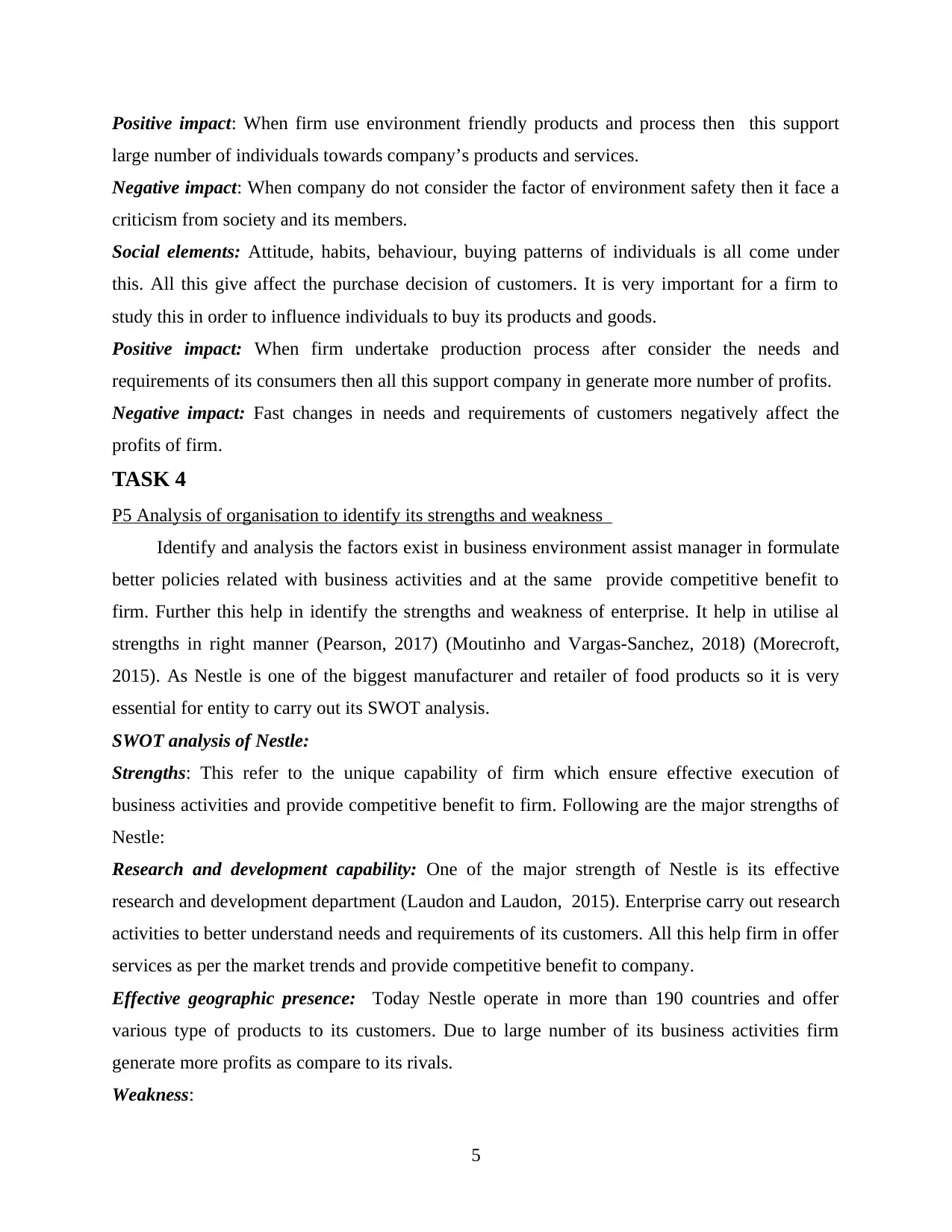
Positive impact: When firm use environment friendly products and process then this support
large number of individuals towards company’s products and services.
Negative impact: When company do not consider the factor of environment safety then it face a
criticism from society and its members.
Social elements: Attitude, habits, behaviour, buying patterns of individuals is all come under
this. All this give affect the purchase decision of customers. It is very important for a firm to
study this in order to influence individuals to buy its products and goods.
Positive impact: When firm undertake production process after consider the needs and
requirements of its consumers then all this support company in generate more number of profits.
Negative impact: Fast changes in needs and requirements of customers negatively affect the
profits of firm.
TASK 4
P5 Analysis of organisation to identify its strengths and weakness
Identify and analysis the factors exist in business environment assist manager in formulate
better policies related with business activities and at the same provide competitive benefit to
firm. Further this help in identify the strengths and weakness of enterprise. It help in utilise al
strengths in right manner (Pearson, 2017) (Moutinho and Vargas-Sanchez, 2018) (Morecroft,
2015). As Nestle is one of the biggest manufacturer and retailer of food products so it is very
essential for entity to carry out its SWOT analysis.
SWOT analysis of Nestle:
Strengths: This refer to the unique capability of firm which ensure effective execution of
business activities and provide competitive benefit to firm. Following are the major strengths of
Nestle:
Research and development capability: One of the major strength of Nestle is its effective
research and development department (Laudon and Laudon, 2015). Enterprise carry out research
activities to better understand needs and requirements of its customers. All this help firm in offer
services as per the market trends and provide competitive benefit to company.
Effective geographic presence: Today Nestle operate in more than 190 countries and offer
various type of products to its customers. Due to large number of its business activities firm
generate more profits as compare to its rivals.
Weakness:
5
large number of individuals towards company’s products and services.
Negative impact: When company do not consider the factor of environment safety then it face a
criticism from society and its members.
Social elements: Attitude, habits, behaviour, buying patterns of individuals is all come under
this. All this give affect the purchase decision of customers. It is very important for a firm to
study this in order to influence individuals to buy its products and goods.
Positive impact: When firm undertake production process after consider the needs and
requirements of its consumers then all this support company in generate more number of profits.
Negative impact: Fast changes in needs and requirements of customers negatively affect the
profits of firm.
TASK 4
P5 Analysis of organisation to identify its strengths and weakness
Identify and analysis the factors exist in business environment assist manager in formulate
better policies related with business activities and at the same provide competitive benefit to
firm. Further this help in identify the strengths and weakness of enterprise. It help in utilise al
strengths in right manner (Pearson, 2017) (Moutinho and Vargas-Sanchez, 2018) (Morecroft,
2015). As Nestle is one of the biggest manufacturer and retailer of food products so it is very
essential for entity to carry out its SWOT analysis.
SWOT analysis of Nestle:
Strengths: This refer to the unique capability of firm which ensure effective execution of
business activities and provide competitive benefit to firm. Following are the major strengths of
Nestle:
Research and development capability: One of the major strength of Nestle is its effective
research and development department (Laudon and Laudon, 2015). Enterprise carry out research
activities to better understand needs and requirements of its customers. All this help firm in offer
services as per the market trends and provide competitive benefit to company.
Effective geographic presence: Today Nestle operate in more than 190 countries and offer
various type of products to its customers. Due to large number of its business activities firm
generate more profits as compare to its rivals.
Weakness:
5
Paraphrase This Document
Need a fresh take? Get an instant paraphrase of this document with our AI Paraphraser
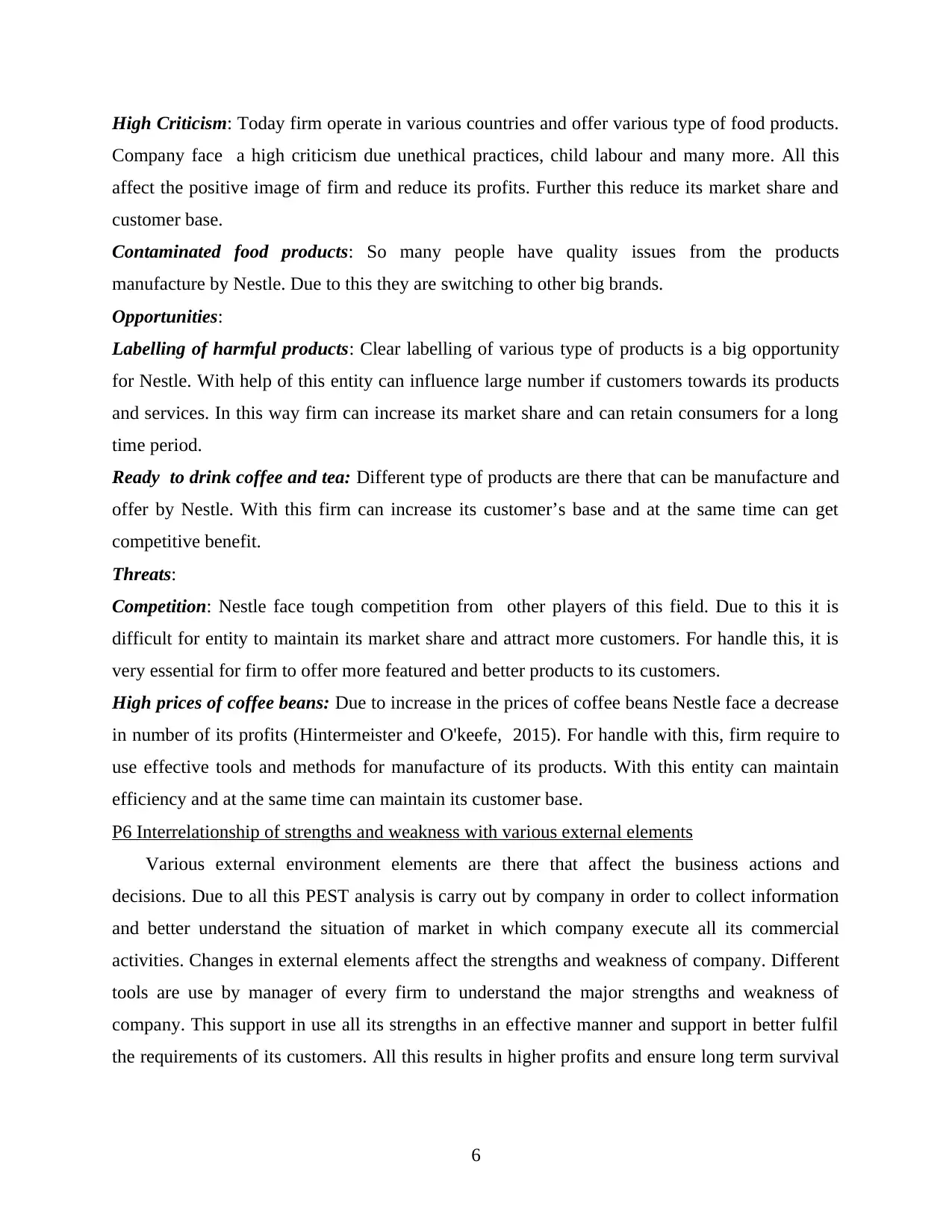
High Criticism: Today firm operate in various countries and offer various type of food products.
Company face a high criticism due unethical practices, child labour and many more. All this
affect the positive image of firm and reduce its profits. Further this reduce its market share and
customer base.
Contaminated food products: So many people have quality issues from the products
manufacture by Nestle. Due to this they are switching to other big brands.
Opportunities:
Labelling of harmful products: Clear labelling of various type of products is a big opportunity
for Nestle. With help of this entity can influence large number if customers towards its products
and services. In this way firm can increase its market share and can retain consumers for a long
time period.
Ready to drink coffee and tea: Different type of products are there that can be manufacture and
offer by Nestle. With this firm can increase its customer’s base and at the same time can get
competitive benefit.
Threats:
Competition: Nestle face tough competition from other players of this field. Due to this it is
difficult for entity to maintain its market share and attract more customers. For handle this, it is
very essential for firm to offer more featured and better products to its customers.
High prices of coffee beans: Due to increase in the prices of coffee beans Nestle face a decrease
in number of its profits (Hintermeister and O'keefe, 2015). For handle with this, firm require to
use effective tools and methods for manufacture of its products. With this entity can maintain
efficiency and at the same time can maintain its customer base.
P6 Interrelationship of strengths and weakness with various external elements
Various external environment elements are there that affect the business actions and
decisions. Due to all this PEST analysis is carry out by company in order to collect information
and better understand the situation of market in which company execute all its commercial
activities. Changes in external elements affect the strengths and weakness of company. Different
tools are use by manager of every firm to understand the major strengths and weakness of
company. This support in use all its strengths in an effective manner and support in better fulfil
the requirements of its customers. All this results in higher profits and ensure long term survival
6
Company face a high criticism due unethical practices, child labour and many more. All this
affect the positive image of firm and reduce its profits. Further this reduce its market share and
customer base.
Contaminated food products: So many people have quality issues from the products
manufacture by Nestle. Due to this they are switching to other big brands.
Opportunities:
Labelling of harmful products: Clear labelling of various type of products is a big opportunity
for Nestle. With help of this entity can influence large number if customers towards its products
and services. In this way firm can increase its market share and can retain consumers for a long
time period.
Ready to drink coffee and tea: Different type of products are there that can be manufacture and
offer by Nestle. With this firm can increase its customer’s base and at the same time can get
competitive benefit.
Threats:
Competition: Nestle face tough competition from other players of this field. Due to this it is
difficult for entity to maintain its market share and attract more customers. For handle this, it is
very essential for firm to offer more featured and better products to its customers.
High prices of coffee beans: Due to increase in the prices of coffee beans Nestle face a decrease
in number of its profits (Hintermeister and O'keefe, 2015). For handle with this, firm require to
use effective tools and methods for manufacture of its products. With this entity can maintain
efficiency and at the same time can maintain its customer base.
P6 Interrelationship of strengths and weakness with various external elements
Various external environment elements are there that affect the business actions and
decisions. Due to all this PEST analysis is carry out by company in order to collect information
and better understand the situation of market in which company execute all its commercial
activities. Changes in external elements affect the strengths and weakness of company. Different
tools are use by manager of every firm to understand the major strengths and weakness of
company. This support in use all its strengths in an effective manner and support in better fulfil
the requirements of its customers. All this results in higher profits and ensure long term survival
6
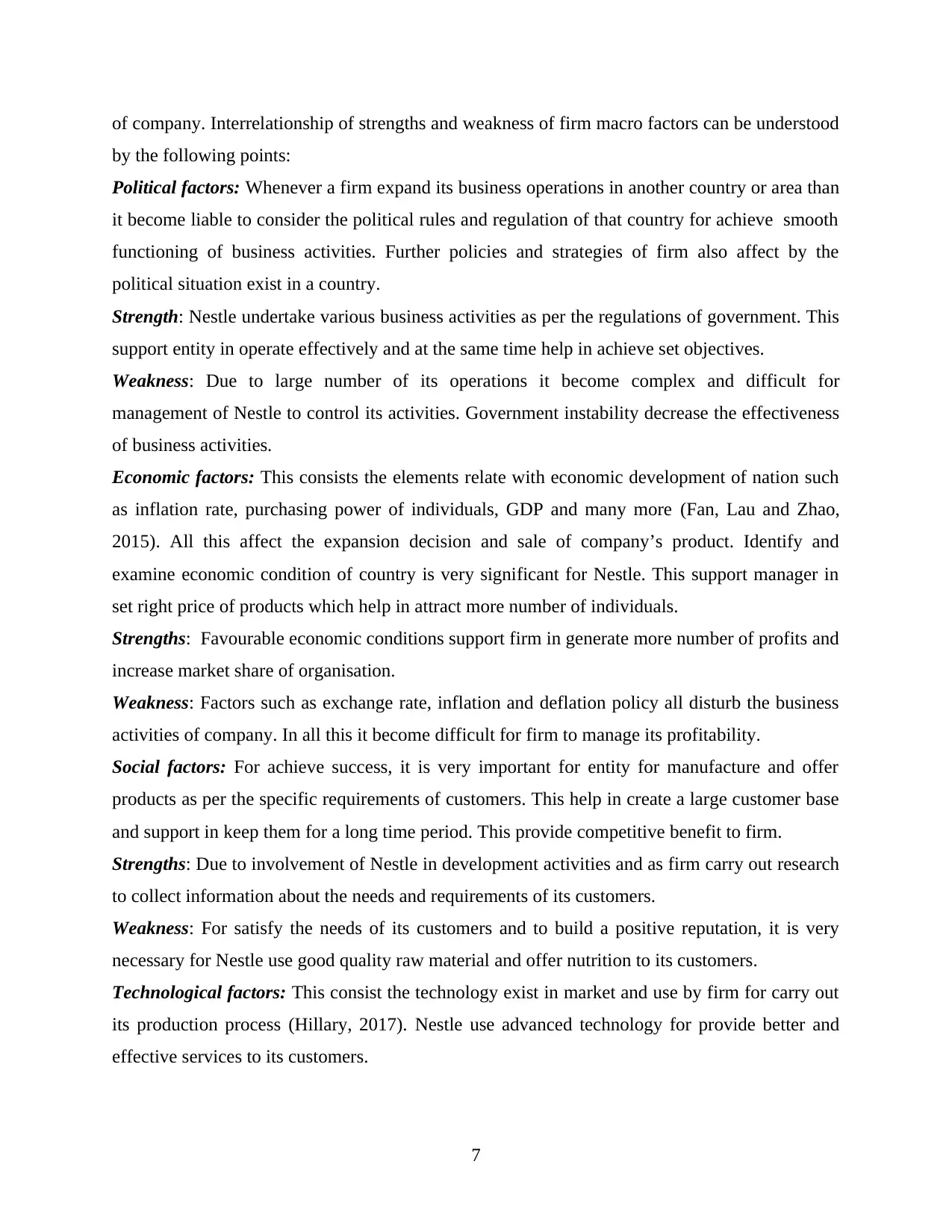
of company. Interrelationship of strengths and weakness of firm macro factors can be understood
by the following points:
Political factors: Whenever a firm expand its business operations in another country or area than
it become liable to consider the political rules and regulation of that country for achieve smooth
functioning of business activities. Further policies and strategies of firm also affect by the
political situation exist in a country.
Strength: Nestle undertake various business activities as per the regulations of government. This
support entity in operate effectively and at the same time help in achieve set objectives.
Weakness: Due to large number of its operations it become complex and difficult for
management of Nestle to control its activities. Government instability decrease the effectiveness
of business activities.
Economic factors: This consists the elements relate with economic development of nation such
as inflation rate, purchasing power of individuals, GDP and many more (Fan, Lau and Zhao,
2015). All this affect the expansion decision and sale of company’s product. Identify and
examine economic condition of country is very significant for Nestle. This support manager in
set right price of products which help in attract more number of individuals.
Strengths: Favourable economic conditions support firm in generate more number of profits and
increase market share of organisation.
Weakness: Factors such as exchange rate, inflation and deflation policy all disturb the business
activities of company. In all this it become difficult for firm to manage its profitability.
Social factors: For achieve success, it is very important for entity for manufacture and offer
products as per the specific requirements of customers. This help in create a large customer base
and support in keep them for a long time period. This provide competitive benefit to firm.
Strengths: Due to involvement of Nestle in development activities and as firm carry out research
to collect information about the needs and requirements of its customers.
Weakness: For satisfy the needs of its customers and to build a positive reputation, it is very
necessary for Nestle use good quality raw material and offer nutrition to its customers.
Technological factors: This consist the technology exist in market and use by firm for carry out
its production process (Hillary, 2017). Nestle use advanced technology for provide better and
effective services to its customers.
7
by the following points:
Political factors: Whenever a firm expand its business operations in another country or area than
it become liable to consider the political rules and regulation of that country for achieve smooth
functioning of business activities. Further policies and strategies of firm also affect by the
political situation exist in a country.
Strength: Nestle undertake various business activities as per the regulations of government. This
support entity in operate effectively and at the same time help in achieve set objectives.
Weakness: Due to large number of its operations it become complex and difficult for
management of Nestle to control its activities. Government instability decrease the effectiveness
of business activities.
Economic factors: This consists the elements relate with economic development of nation such
as inflation rate, purchasing power of individuals, GDP and many more (Fan, Lau and Zhao,
2015). All this affect the expansion decision and sale of company’s product. Identify and
examine economic condition of country is very significant for Nestle. This support manager in
set right price of products which help in attract more number of individuals.
Strengths: Favourable economic conditions support firm in generate more number of profits and
increase market share of organisation.
Weakness: Factors such as exchange rate, inflation and deflation policy all disturb the business
activities of company. In all this it become difficult for firm to manage its profitability.
Social factors: For achieve success, it is very important for entity for manufacture and offer
products as per the specific requirements of customers. This help in create a large customer base
and support in keep them for a long time period. This provide competitive benefit to firm.
Strengths: Due to involvement of Nestle in development activities and as firm carry out research
to collect information about the needs and requirements of its customers.
Weakness: For satisfy the needs of its customers and to build a positive reputation, it is very
necessary for Nestle use good quality raw material and offer nutrition to its customers.
Technological factors: This consist the technology exist in market and use by firm for carry out
its production process (Hillary, 2017). Nestle use advanced technology for provide better and
effective services to its customers.
7
⊘ This is a preview!⊘
Do you want full access?
Subscribe today to unlock all pages.

Trusted by 1+ million students worldwide
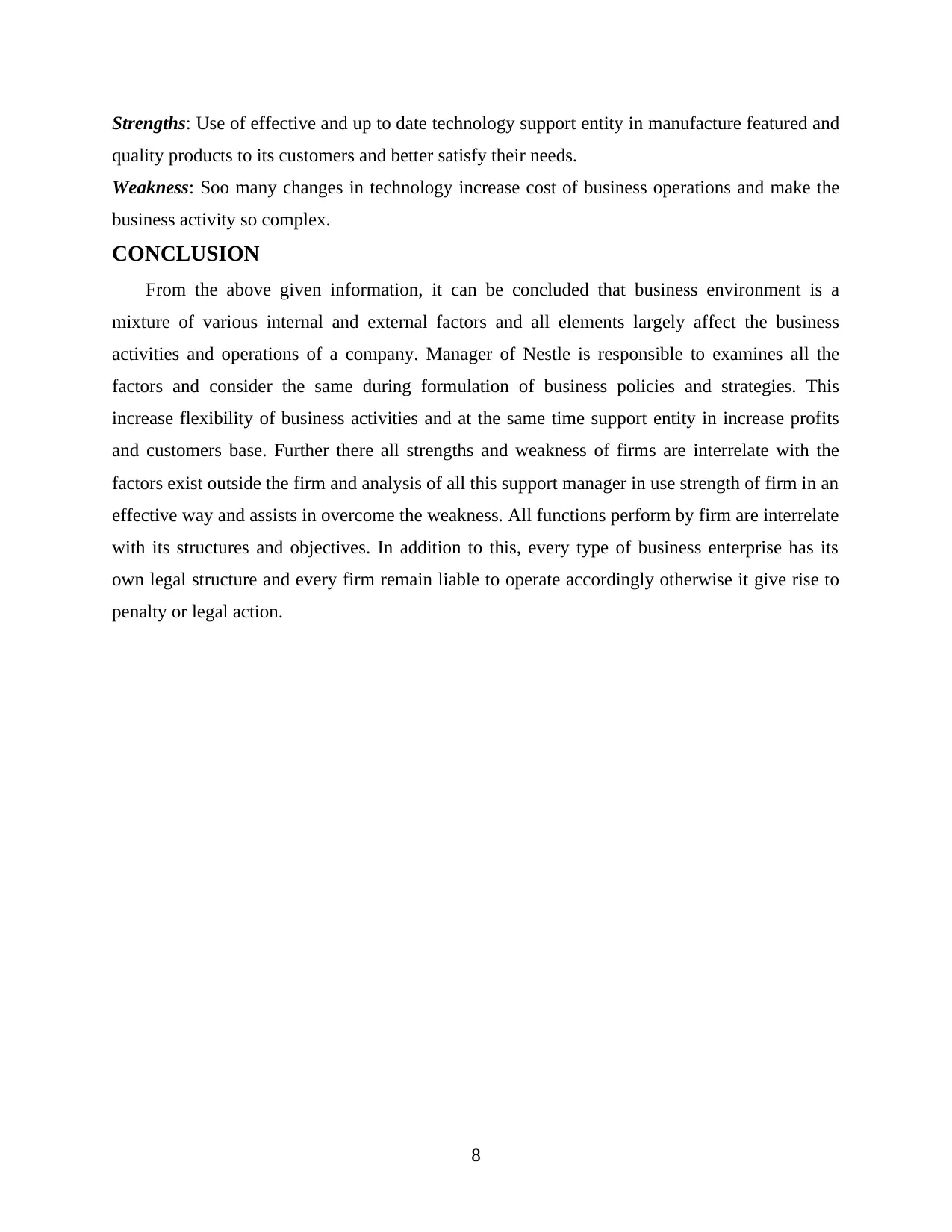
Strengths: Use of effective and up to date technology support entity in manufacture featured and
quality products to its customers and better satisfy their needs.
Weakness: Soo many changes in technology increase cost of business operations and make the
business activity so complex.
CONCLUSION
From the above given information, it can be concluded that business environment is a
mixture of various internal and external factors and all elements largely affect the business
activities and operations of a company. Manager of Nestle is responsible to examines all the
factors and consider the same during formulation of business policies and strategies. This
increase flexibility of business activities and at the same time support entity in increase profits
and customers base. Further there all strengths and weakness of firms are interrelate with the
factors exist outside the firm and analysis of all this support manager in use strength of firm in an
effective way and assists in overcome the weakness. All functions perform by firm are interrelate
with its structures and objectives. In addition to this, every type of business enterprise has its
own legal structure and every firm remain liable to operate accordingly otherwise it give rise to
penalty or legal action.
8
quality products to its customers and better satisfy their needs.
Weakness: Soo many changes in technology increase cost of business operations and make the
business activity so complex.
CONCLUSION
From the above given information, it can be concluded that business environment is a
mixture of various internal and external factors and all elements largely affect the business
activities and operations of a company. Manager of Nestle is responsible to examines all the
factors and consider the same during formulation of business policies and strategies. This
increase flexibility of business activities and at the same time support entity in increase profits
and customers base. Further there all strengths and weakness of firms are interrelate with the
factors exist outside the firm and analysis of all this support manager in use strength of firm in an
effective way and assists in overcome the weakness. All functions perform by firm are interrelate
with its structures and objectives. In addition to this, every type of business enterprise has its
own legal structure and every firm remain liable to operate accordingly otherwise it give rise to
penalty or legal action.
8
Paraphrase This Document
Need a fresh take? Get an instant paraphrase of this document with our AI Paraphraser
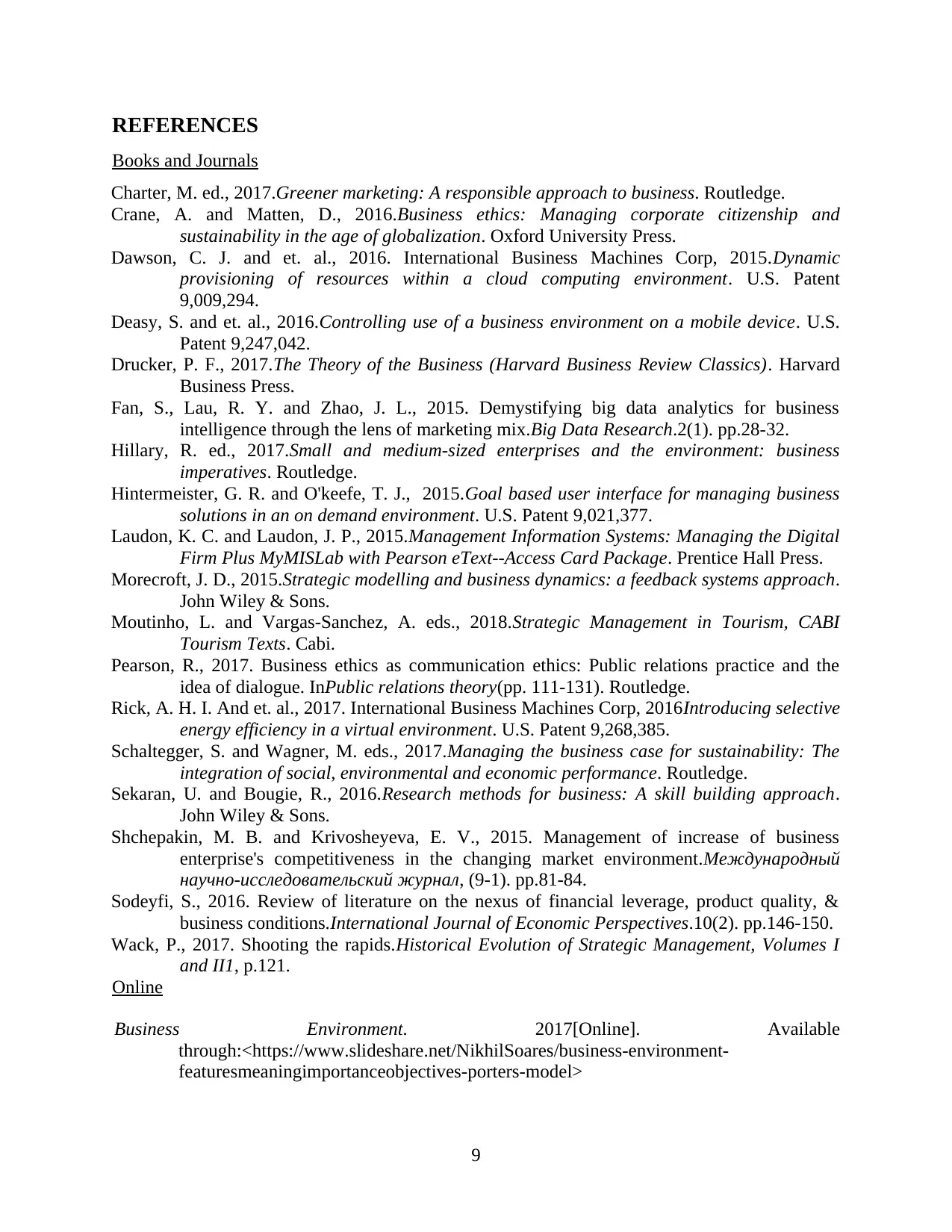
REFERENCES
Books and Journals
Charter, M. ed., 2017.Greener marketing: A responsible approach to business. Routledge.
Crane, A. and Matten, D., 2016.Business ethics: Managing corporate citizenship and
sustainability in the age of globalization. Oxford University Press.
Dawson, C. J. and et. al., 2016. International Business Machines Corp, 2015.Dynamic
provisioning of resources within a cloud computing environment. U.S. Patent
9,009,294.
Deasy, S. and et. al., 2016.Controlling use of a business environment on a mobile device. U.S.
Patent 9,247,042.
Drucker, P. F., 2017.The Theory of the Business (Harvard Business Review Classics). Harvard
Business Press.
Fan, S., Lau, R. Y. and Zhao, J. L., 2015. Demystifying big data analytics for business
intelligence through the lens of marketing mix.Big Data Research.2(1). pp.28-32.
Hillary, R. ed., 2017.Small and medium-sized enterprises and the environment: business
imperatives. Routledge.
Hintermeister, G. R. and O'keefe, T. J., 2015.Goal based user interface for managing business
solutions in an on demand environment. U.S. Patent 9,021,377.
Laudon, K. C. and Laudon, J. P., 2015.Management Information Systems: Managing the Digital
Firm Plus MyMISLab with Pearson eText--Access Card Package. Prentice Hall Press.
Morecroft, J. D., 2015.Strategic modelling and business dynamics: a feedback systems approach.
John Wiley & Sons.
Moutinho, L. and Vargas-Sanchez, A. eds., 2018.Strategic Management in Tourism, CABI
Tourism Texts. Cabi.
Pearson, R., 2017. Business ethics as communication ethics: Public relations practice and the
idea of dialogue. InPublic relations theory(pp. 111-131). Routledge.
Rick, A. H. I. And et. al., 2017. International Business Machines Corp, 2016Introducing selective
energy efficiency in a virtual environment. U.S. Patent 9,268,385.
Schaltegger, S. and Wagner, M. eds., 2017.Managing the business case for sustainability: The
integration of social, environmental and economic performance. Routledge.
Sekaran, U. and Bougie, R., 2016.Research methods for business: A skill building approach.
John Wiley & Sons.
Shchepakin, M. B. and Krivosheyeva, E. V., 2015. Management of increase of business
enterprise's competitiveness in the changing market environment.Международный
научно-исследовательский журнал, (9-1). pp.81-84.
Sodeyfi, S., 2016. Review of literature on the nexus of financial leverage, product quality, &
business conditions.International Journal of Economic Perspectives.10(2). pp.146-150.
Wack, P., 2017. Shooting the rapids.Historical Evolution of Strategic Management, Volumes I
and II1, p.121.
Online
Business Environment. 2017[Online]. Available
through:<https://www.slideshare.net/NikhilSoares/business-environment-
featuresmeaningimportanceobjectives-porters-model>
9
Books and Journals
Charter, M. ed., 2017.Greener marketing: A responsible approach to business. Routledge.
Crane, A. and Matten, D., 2016.Business ethics: Managing corporate citizenship and
sustainability in the age of globalization. Oxford University Press.
Dawson, C. J. and et. al., 2016. International Business Machines Corp, 2015.Dynamic
provisioning of resources within a cloud computing environment. U.S. Patent
9,009,294.
Deasy, S. and et. al., 2016.Controlling use of a business environment on a mobile device. U.S.
Patent 9,247,042.
Drucker, P. F., 2017.The Theory of the Business (Harvard Business Review Classics). Harvard
Business Press.
Fan, S., Lau, R. Y. and Zhao, J. L., 2015. Demystifying big data analytics for business
intelligence through the lens of marketing mix.Big Data Research.2(1). pp.28-32.
Hillary, R. ed., 2017.Small and medium-sized enterprises and the environment: business
imperatives. Routledge.
Hintermeister, G. R. and O'keefe, T. J., 2015.Goal based user interface for managing business
solutions in an on demand environment. U.S. Patent 9,021,377.
Laudon, K. C. and Laudon, J. P., 2015.Management Information Systems: Managing the Digital
Firm Plus MyMISLab with Pearson eText--Access Card Package. Prentice Hall Press.
Morecroft, J. D., 2015.Strategic modelling and business dynamics: a feedback systems approach.
John Wiley & Sons.
Moutinho, L. and Vargas-Sanchez, A. eds., 2018.Strategic Management in Tourism, CABI
Tourism Texts. Cabi.
Pearson, R., 2017. Business ethics as communication ethics: Public relations practice and the
idea of dialogue. InPublic relations theory(pp. 111-131). Routledge.
Rick, A. H. I. And et. al., 2017. International Business Machines Corp, 2016Introducing selective
energy efficiency in a virtual environment. U.S. Patent 9,268,385.
Schaltegger, S. and Wagner, M. eds., 2017.Managing the business case for sustainability: The
integration of social, environmental and economic performance. Routledge.
Sekaran, U. and Bougie, R., 2016.Research methods for business: A skill building approach.
John Wiley & Sons.
Shchepakin, M. B. and Krivosheyeva, E. V., 2015. Management of increase of business
enterprise's competitiveness in the changing market environment.Международный
научно-исследовательский журнал, (9-1). pp.81-84.
Sodeyfi, S., 2016. Review of literature on the nexus of financial leverage, product quality, &
business conditions.International Journal of Economic Perspectives.10(2). pp.146-150.
Wack, P., 2017. Shooting the rapids.Historical Evolution of Strategic Management, Volumes I
and II1, p.121.
Online
Business Environment. 2017[Online]. Available
through:<https://www.slideshare.net/NikhilSoares/business-environment-
featuresmeaningimportanceobjectives-porters-model>
9
1 out of 11
Related Documents
Your All-in-One AI-Powered Toolkit for Academic Success.
+13062052269
info@desklib.com
Available 24*7 on WhatsApp / Email
![[object Object]](/_next/static/media/star-bottom.7253800d.svg)
Unlock your academic potential
Copyright © 2020–2025 A2Z Services. All Rights Reserved. Developed and managed by ZUCOL.





